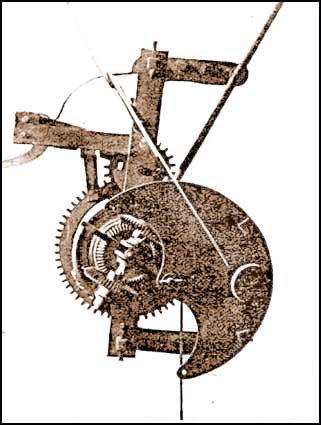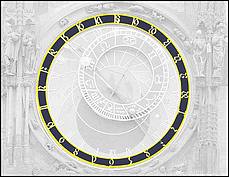
The mechanism of the 24-hour dial
The dial itself

The term “24-hour dial” describes a dial with 24 numbers along its perimeter, which corresponds to the number of hours within one solar day. That is why one pointer is sufficient for a clock to indicate time. Czech medieval clocks could have looked similarly to the one on the town hall in Tábor, only the numerals were created during the historicist neo-Gothic reconstruction in 1878. However, let us not be confused by the clock on the provost church in Havlíčkův Brod. This clock has two dials and one of them has also a 24hour dial (1929) but with two pointers. However, both dials indicate the same time. Another thing to note is where the individual dials have the 24th hour.
In the Middle Ages, Roman numerals were used just as they are used in Venice in Italy up until today. Arabic numerals were not known in Europe yet. In Bohemia, they did not begin to be used until the 15th century. The original Arabic numerals, of course, look quite differently but they use the decimal system, i.e. numerals 0–9.
The numerals on the 24hour dial in Prague were created later in the style of Gothic lanceted font, the Czech bastard, which was used at the court of Emperor Charles IV. This font was also used for the first printed books. In later historical periods, the shape of the characters returned to its Roman origins. The Capital characters known from Roman monumental columns is over two thousand years old and is a delightfully balanced font even today. So today we use Roman characters for writing and Arabic numerals.
This chapter describes the mechanism for setting the Old Czech Time from the inside the clock. We also discuss the Old Czech Time in detail in the chapter on the astrolabe, i. e. on the outer appearance of the Prague astronomical clock. Let us remind that the day in the Old Czech Time ended and commenced at sunset. This moment was 24 and also 0 hours.
Problems arose in the moment when Roman numerals of the German time, i. e. socalled halfclock, appeared on the dial; the dial was divided into 2 x 12 numerals. The German time was used concurrently with the Old Czech Time (then, of course, just Czech) since the time of King Ferdinand I (1547) and its establishment on the astronomical clock is credited to J. Táborský, who was the clockmaster since 1552. He plotted the sunset curve on the plate and coloured the field of the day in blue; the golden hand began to indicate both the times. He also transmitted the pendulous movement from the calendarium to the ring of the 24hour dial. Thus he automated the entire clock machine.
Current state
Let us begin in an unusual way in historical terms, i. e. from the current machine that is installed today on the astronomical clock. It was calculated and constructed in 1957 be F. Kadeřávek and doc. E. Procházka from the Czech Technical University and Dr. Z. Horský. It is the youngest mechanism on the clock. An essential part of it is made of light metals, so it lacks the ironmade and technical beauty of the parts from the past centuries but it is purely functional and very precise. It is almost entirely hidden behind the clock machine and is difficult to understand on transversal sight.


The machine has seven tooth wheels. The cam with calendar days is profiled around a pulley, which is connected to the toothed segment. The segment is attached around the axle of the astronomical dial by a flange in such a way that it does not intervene into other machines nor other parts. The segment then controls the tooth wheels. The movement of this transmission is conducted outside the astronomical clock by the topmost and also smallest wheel.



The shape of the toothed segment shows in what angle the 24-hour dial moves in the course of the year; it is approximately 60°. When the Sun is in the positions of the tropics – the tropic of Cancer in the summer being the highest position and the tropic of Capricorn being the lowest – the entire system significantly slows down its speed and then returns. The change of direction of the transmission and its backward rotation is ensured by the shape of the cam mentioned above. The entire mechanism has its own clock machine.


The smallest wheel of the internal mechanism transmits the movement in front of the clock and acts as a pinion. It drives the internal tooth system of the annulus of the 24hour dial in the topmost point of the circle. The ring has the largest diameter on the clock, 300 cm, and is 20 cm wide. Side pulleys bear the entire weight of the 24hour dial; moreover, three securing lugs support it on the sides and at the bottom. This principle was also used in the original mechanism.

The weight of the 24hour dial is enormous and so are the resistances in the mechanical system of its rotation. The toothed segment with the wheel copying the perimeter of the cam therefore needs to be sufficiently weighted so that it seats on the perimeter of the cam all the time and rotates the 24hour dial fluently during the entire 6 months by 62.5° to the right. During this half a year, it is just this weight that rotates the 24hour dial. During the period between the summer and winter solstice, though, the situation is inverted and the machine rotating the cam must put up not only with the friction but also with the weight of the weighted segment that is now lifted by the cam. This requires, besides the powerful machine rotating the cam, also another additional left machine that provides the cam with a torque in the direction of its movement. The machine rotating the cam, located on the wall on the right side, is released by the chronometer every minute together with the main machine of the clock. The long connecting shaft on the outlet of this machine rotates at a speed of one turn per 5 days and is connected with the cam on the other end through a 73/1 transmission.
During the repair in 1948 after the World War II, the 24hour dial was not put into operation. The dial did not move and remained in the position 12 at the top and 24 at the bottom. The function of swivelling of the 24hour dial and indication of the Old Czech Time was not resumed until the installation of this new mechanism in 1957.
The machine from 1865
The machine from 1865 is described on the drawings in the Rosický’s book from 1923 (the other machines of the clock are not depicted in front of the dial). The machine was designed and constructed by V. Daněk and J. Holub. The function is evident from the lateral scheme, the complex drawing of the dial and the detail of the releasing device. The upper wheel (which remained even after the reconstruction in 1948) was rotated by a long transmission bar. There were three tooth wheels with conical tooth system in the releasing device. The wheels were shifted by a lever in such a way that only two of them were engaged. By shifting and thus engaging the opposite wheel, the direction of rotation was reversed. The device was maintained in tense by a weight, winded manually on a drum through a ratchetwheel and a ratchet. Rosický states that the device is controlled by the calendar machine but it was only manual setting that was used in his time. The main reason for using manual setting was a poor accuracy of the entire system. The device was controlled and released by the calendar wheel with pins attached in irregular intervals on its perimeter; the pins are there until today. The adjustment was such that the device does not move until the difference between the actual moment of the sunset and the setting of the dial exceeds 8 minutes. This difference is achieved in mere six days around equinoxes. Later a tolerance of 4minute deviation from the reality was established. At solstices, when the 24hour dial reverses its direction, the mechanism could be standstill for approx. 30 days. However, it would have been necessary to increase the number of the releasing pins. That is why the manual setting using a crank attached directly to the device began to be used. Manual setting did not impose a problem as the astronomical clock required a continuous care – checking and manual winding of ropes onto drums – even after the repair. Just a reminder: in 1865, electricity has not yet been installed. The pins are on the calendar wheel until today. And the clock still undergoes a regular check once a week even today.


The oldest known solution
When we proceed backwards to the history, a dial driven by means of a crank is mentioned. There is much less information on this mechanism; it was described by B. Balbín in 1681. The crank mechanism consists in a system with variable transmission; the crank with a connecting rod leading from the calendar machine moved the dial at a variable speed. Around the dead points, the rod moves at the lowest speed; it was in the time of the summer and winter solstices. This way, Táborský completed the automatic connection between individual parts of the clock in 1566; the rotation of the calendar plate was controlled in a similar way. The astronomical clock was also equipped with small roofing that protected the shutters against the weather.
In the end, a brief remark on the socalled German time. It was introduced at the end of the Middle Ages and is used today all over the world. In 1547, it was introduced in Bohemia by the creator of the Habsburg Empire in central Europe, Ferdinand I Habsburg. It was finally ordered in 1621 by Ferdinand II. What is remarkable is that both orders were issued after risings of the Estates. The first one was short but the second one, which began by defenestration, ended up with the Battle of White Mountain. However, the German time was indicated on the Prague astronomical clock concurrently with the Old Czech Time since the times of J. Táborský and so has been up until today.


